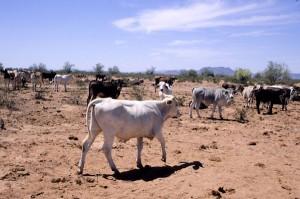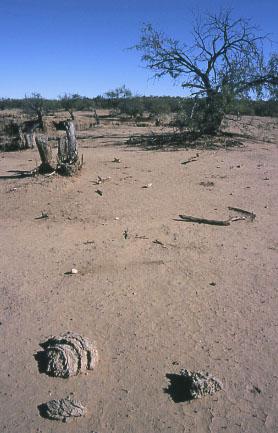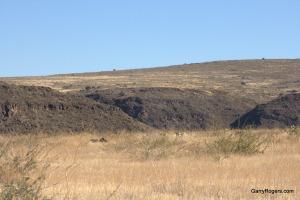Livestock and Plant Invasions
Using natural landscapes for any purpose requires caution to prevent plant invasions. An essential task for nature conservation is explaining this to the public.

Cattle in the Sonoran Desert. Heavily trampled soil without soil microorganisms that can absorb and store moisture, convert solar energy to nutrients, increase plant root efficiency, and protect the soil surface from erosion and invasive plants. Photo by George Wuerthner.
Most investigations of plant invasions assign responsibility to Humans. In our ignorance, we introduce potentially invasive plants from foreign ecosystems, and then we disturb native ecosystems and help the introduced plants get established and spread. We have learned that diseases, predators, competitors, and supportive soil microorganisms control plant growth. Move plants to new locations where their natural controls aren’t present and they sometimes explode across the landscape.
After introduction, the principal human disturbances responsible for plant invasions in the desert are domestic livestock grazing, construction, fire, recreation, and climate change. Scientists have concluded that soil disturbance and seed dispersal by domestic livestock are the principal historic events that introduced and spread weeds into natural ecosystems of the western U. S. (Mack 1981, Belsky and Gelbard 2000, McAuliffe 1998, Rutman 1998, Morrison et al. 2003 and others).
According to Belsky and Gelbard (2000: 3), domestic livestock contribute to plant invasions by:
- transporting weed seeds on their coats and feet and in their guts,
- grazing native plant species and not introduced species,
- creating patches of bare, disturbed soils that act as weed seedbeds,
- destroying micro biotic crusts that stabilize soils and inhibit weed seed germination,
- creating patches of nitrogen-rich soils, which favor some weed species,
- reducing concentrations of soil mycorrhizae required by most western native species,
- accelerating soil erosion to create vacant sites for invasive species to occupy.
Livestock grazing began soon after Europeans reached western North America in the 1500’s (reviewed by Turner et al. 2003). Since then, introduced plants have become abundant across all arid habitats, and new ones continue to appear. When Jeff Steele and I began our study of desert fires in 1974 (Rogers and Steele 1980), the principal weeds in the Sonoran Desert were Red Brome (Bromus rubens) and Alfilaria (Erodium cicutarium). Since then, Buffelgrass (Pennisetum ciliare), and Sahara Mustard (Brassica tournefortii, aka Asian Mustard) have become serious problems. And there are others.
Range managers once believed that plants were interchangeable between locations. They imported foreign species to provide better livestock forage or fill other needs. For instance, they introduced Buffelgrass and Lehmann Lovegrass (Eragrostis lehmanniana) to protect arid sites denuded by livestock grazing. As recently as 1988, managers continued to plant both species on desert ranges (Cox et al. 1988). Now we know that these species are among the most harmful in our deserts (AZ-WIPWG 2009, Bock et al. 1986, Bock et al. 2007, and the S. AZ Buffelgrass website).

Cattle-grazed annual grassland during the dry season. Small mammals, reptiles and ground nesting birds such as the masked bobwhite could no longer survive here by the late 19th century due to lack of cover—predators easily picked them off. With no prey remaining, predator populations also crashed. Arizona State Land west of Route 286 at Mile Mark 30. Late October 1997. This photo appears in Welfare Ranching (Wuerthner and Matteson 2002), 40.
Perhaps the greatest damage by livestock has been to biological soil crusts (BSCs). Numerous studies report that even light cattle grazing damages BSCs (Kleiner and Harper 1977, Anderson et al. 1982, Brotherson et al. 1983, Johansen 1986). BSCs stabilize soils and block invasive species. These benefits plus the slow recovery of BSCs after livestock trampling should place them in the forefront of concerns for range managers. Strategies for managing livestock grazing to protect BSCs are described by Belnap et al. (2001), Marble and Harper (1989), Memmott et al. (1998), Miller et al. (1994), Burkhardt (1996), Kaltenecker and Wicklow-Howard 1994, and Kaltenecker et al. (1999b).
Livestock grazing and fire prone invasive species are an irresistible force for change. In the Great Basin Desert, the small Eurasian Cheatgrass has replaced more than 100 million acres of native Great Basin vegetation. When Hull (1965) wrote about the positive feedback loop connecting Cheatgrass and fire in the Great Basin, he was echoing earlier comments by Aldo Leopold (Leopold 1949: 154-158) who identified livestock grazing as the principal disturbance that admitted weeds, and fires as the chief force behind Cheatgrass replacement of native species.

Black Mesa. A few fire resistant shrubs and cacti persist among the invasive weeds.
Clear cases of similar changes are found throughout the U. S. arid lands. Invasive plants increase fire frequency, and native plants begin dropping out. In many instances, range managers allow livestock grazing on recently burned lands. Since the cows often go after native plants, the loss of native species accelerates. On Black Mesa, not far from my home, fires and continued grazing have allowed invasive species to almost completely replace native herbs and shrubs. Range ecologists have often pointed out that the weed vegetation on Black Mesa has reduced livestock carrying capacity, lowered biological diversity, and increased flammability.
Future of Livestock Grazing and Plant Invasions in North American Deserts
For North American deserts, three contemporary realities make it desirable and politically feasible to restrict livestock grazing. First, extensive research has confirmed that plant invasions and replacement of native ecosystems reduces forage production and increases fire danger (Leopold 1949, and many others in the References). Second, as housing and urban development have replaced productive lands, grazing resources have dwindled, and there has been a general decline in numbers of livestock on the public land (McClaran et al. 1992). Third, multiple uses of the public lands have begun to diminish the relative economic importance of grazing (e.g., Pope and Wagstaff 1987, Mathews et al. 2002).
According to the U. S. Department of Agriculture (Mathews et al. 2002), grazing on public lands of the 17 western states (cattle and sheep) amounts to about 1 percent of total domestic product for those states. During the period 1988-1997, BLM grazing permit receipts declined by about 30%, and in 1997 equaled 6.7% of BLM revenue from all non-government sources.
Livestock grazing is more important in most regions of the world than in North America. As the human population continues to grow and as long as people continue to consume animals, ecosystems will continue to deteriorate. Even if animal consumption ends, continued population increase will eventually be impossible to feed everyone. Water and irrigable land scarcity could replace energy resource scarcity as the principal cause of war. And then, as foretold by many dystopian novelists (e.g., Harrison 1966), the wars could shrink to small desperate struggles as Homo sapiens’ twilight falls.
References for Plant Invasions
Ames, C. R. 1977. Wildlife conflicts in riparian management: grazing. Pages 49-52 in R. R. Johnson and D. A. Jones, tech coords. Importance, preservation, and management of riparian habitats: A symposium. USDA Forest Service General Technical Report RM-43. Rocky Mountain Forest and Range Experiment Station. Fort Collins, CO. 217 p.
Anderson, D. C., K. T. Harper, and S. R. Rushforth. 1982. Recovery of cryptogamic soil crusts from grazing on Utah winter ranges. Journal of Range Management 35:355-359.
AZ-WIPG. [Arizona Wildlands Invasive Plant Working Group.] 2009. Invasive non-native plants that threaten wildlands in Arizona: A categorized list developed by AZ-WIPWG. Online: http://sbsc.wr.usgs.gov/research/projects/swepic/swepic.asp.
Belnap, J., J. H. Kaltenecker, R. Rosentreter, J. Williams, S. Leonard, and D. Eldridge. 2001. Biological soil crusts: Ecology and management. USDI BLM Tech Ref 1730-2. 111 p.
Belsky, A. J., and J. L. Gelbard. 2000. Livestock grazing and weed invasion in the arid west. OR Natural Desert Assn, Bend, OR. 31 p.
Belsky, A.J., A. Matzke, and S. Uselman. 1999. Survey of livestock influences on stream and riparian ecosystems in the western United States. Journal of Soil and Water Conservation 54:419-431.
Bock, C. E., J. H. Bock, K. L. Jepson, and J. C. Ortega. 1986. Ecological effects of planting African lovegrasses in Arizona. National Geographic Research 2:456–463.
Bock, C. E., J. H. Bock, L. Kennedy, and Z. F. Jones. 2007. Spread of non-native grasses into grazed versus ungrazed desert grasslands. Journal of Arid Environments lsdkjfsoi.
Brotherson, J.D., S.R. Rushforth, and J.R. Johansen. 1983. Effects of long-term grazing on cryptogamic crust cover in Navajo National Monument, Arizona. Journal of Range Management 36:579-581.
Burkhardt, J.W. 1996. Herbivory in the Intermountain West: An overview of evolutionary history, historic cultural impacts and lessons from the past. Station Bulletin 58. Idaho Forest, Wildlife and Range Experiment Station, University of Idaho, Moscow. 35 p.
Carothers, S. W. 1977. Importance, preservation, and management of riparian habitats: An overview. Pages 210-222 in R. R. Johnson and D. A. Jones, tech coords. Importance, preservation, and management of riparian habitats: A symposium. USDA Forest Service General Technical Report RM-43. Rocky Mountain Forest and Range Experiment Station. Fort Collins, CO. 222 p.
Charley, J. L., and S. W. Cowling. 1968. Changes in soil nutrient status resulting from overgrazing and their consequences in plant communities of semi-arid areas. Proceedings of the Ecological Society of Australia 3:28-38.
Coleman, E. A. 1953. Vegetation and watershed management: An appraisal of vegetation management in relation to water supply, flood control, and soil erosion. Ronald Press, New York, NY. 412 p.
Cox, R.D., and V.J. Anderson. 2004. Increasing native diversity of cheatgrass-dominated rangeland through assisted succession. Journal of Range Management 57:203-210.
D’Antonio, C. M., and P. M. Vitousek. 1992. Biological invasions by exotic grasses, the grass/fire cycle, and global change. Annual Reviews of Ecology and Systematics 23:63-87.
Hall, J.A., S. Weinstein, and C.L. McIntyre. 2005a. The impacts of livestock grazing in the Sonoran Desert: A literature review and synthesis. The Nature Conservancy in Arizona, Tucson. 304 p.
Hobbs, N. T. 1996. Modification of ecosystems by ungulates. Journal of Wildlife Management 60:695-713.
Johansen, J.R. 1986. Importance of cryptogamic soil crusts to arid rangelands: implications for short duration grazing. Pages 58-64 in Tiedeman, J. ed. Short duration grazing. Washington State University, Pullman, WA.
Kaltenecker, J., and M. Wicklow-Howard. 1994. Microbiotic soil crusts in sagebrush habitats of southern Idaho. Contract Report. On file with: Interior Columbia Basin Ecosystem Management Project, Walla Walla, WA. 48 p.
Kaltenecker, J.H., M. Wicklow-Howard, and M. Pellant. 1999a. Biological soil crusts: natural barriers to Bromus tectorumL. establishment in the northern Great Basin, U. S.A. In: Eldridge, D., and D. Freudenberger, eds. Proceedings of the VI International Rangeland Congress, Aitkenvale, Queensland, Australia. Pages 109-111.
Kaltenecker, J.H., M. Wicklow-Howard, and R. Rosentreter. 1999b. Biological soil crusts in three sagebrush communities recovering from a century of livestock trampling. Pages 222-226 in E. D. McArthur, W. K. Ostler, and C. L. Wambolt, Comps. Proceedings: Shrubland Ecotones. Proceedings RMRS-P-11. USDA Forest Service, Rocky Mountain Research Station. Pages 222-226.
Kleiner, E. F., and K. T. Harper. 1977. Soil properties in relation to cryptogamic groundcover in Canyonlands National Park. Journal of Range Management 30:202-205.
Leopold, A. 1949. A Sand County almanac and sketches here and there. Oxford University Press, New York. 226 p.
Mack, R. N. 1981. Invasion of Bromus tectorum L. into western North America: An ecological chronicle. Agro-Ecosystems 7:145-165.
Mack, R. N. 1989. Temperate grasslands vulnerable to plant invasions: Characteristics and consequences. Pages 155-179 in Drake et al., eds. SCOPE 37, biological invasions, a global perspective. John Wiley & Sons, New York. 506 p.
Marble, J. R., and K. T. Harper. 1989. Effect of timing of grazing on soil-surface cryptogamic communities in a Great Basin low-shrub desert: A preliminary report. Great Basin Naturalist 49:104–107.
Martin, S. C. 1979. Evaluating the impacts of cattle grazing on riparian habitats in the national forests of Arizona and New Mexico. Pages 35-38 in O. B. Cope, ed. Proceedings of the forum—Grazing and riparian stream ecosystems. Trout Unlimited, Denver, CO. 94 p.
Mathews, K. H., Jr, K. Ingram, J. Lewandrowski, and J. Dunmore. 2002. Public lands and western communities. USDA Economic Research Service, Agricultural Outlook, June-July:18-22.
Mau-Crimmins, T., A. Hubbard, D. Angell, C. Filippone, N. Kline. 2005. Sonoran Desert Network Vital Signs Monitoring Plan. Technical Report NPS/IMR/SODN-003. National Park Service. Denver, CO.
McAuliffe J. R. 1998. Rangeland water developments: Conservation solution or illusion? Pages 310-359 in Proceedings of a Symposium on Environmental, Economic, And Legal Issues Related to Rangeland Water Developments. 13–15November 1997, Tempe, Arizona. Center for the Study of Law, Science, and Technology, Arizona State University, Tempe.
McClaran, M. P., L. S. Allen, and G. B. Ruyle. 1992. Livestock production and grazing management in the encinal oak woodlands of Arizona. Pages 57-64 in P. F. Ffolliott, G. J. Gottfried, D. A. Bennett, C. V. M. Hernandez, A. Ortega-Rubio, and R. H. Hamre, tech. coords. Ecology and management of oak and associated woodlands: perspectives in the Southwestern United States and Northern Mexico. Gen. Tech. Rep. RM-218. Fort Collins, CO: U.S. Department of Agriculture, Forest Service, Rocky Mountain Forest and Range Experiment Station.
Memmott, K.L., V.J. Anderson, and S.B. Monsen. 1998. Seasonal grazing impact on cryptogamic crusts in a cold desert ecosystem. Journal of Range Management 51:547-550.
Miller, R. F., T. J. Svejcar, and N. E. West. 1994. Implications of livestock grazing in the Intermountain sagebrush region: plant composition. Pages 101-146 in M. Vavra, W. A. Laycock, and R. D. Pieper, eds. Ecological Implications of Livestock Herbivory in the West. Society for Range Management, Denver, CO. Pages 101-146.
Parks, C. G., M. J. Wisdom, and J. G. Kie. 2005. The influence of ungulates on non-native plant invasions in forests and rangelands: A review. Appendix D in Preventing and managing invasive plants final environmental impact statement.
Platts, W. S. 1979. Livestock grazing and riparian/stream ecosystems. Pages 39-45 in O. B. Cope, ed. Proceedings of the forum—Grazing and riparian stream ecosystems. Trout Unlimited, Denver, CO. 94 p.
Pope, C. A. III, and F. J. Wagstaff. 1987. An economic evaluation of the Oak Creek Range Management Area, Utah. General Technical Report INT-224. USDA Forest Service, Intermountain Research Station, Ogden, UT. 14 p.
Reichenbacher, F. W. 1984. Ecology and evaluation of Southwestern riparian plant communities. Desert Plants 6:15-22.
Rogers, G. F. 1982. Then and Now: A Photographic History of Vegetation Change in the Central Great Basin Desert. University of Utah Press, Salt Lake City, UT. 188 pp.
Rogers, G. F. 1983. Influences of Alien Plants on Arid Vegetation Dynamics. Ecological Society of America Symposium: Causes and Consequences of Invasions of Alien Annual Plants in Western North America. Logan, UT.
Rogers, G. F. 1985. Mortality of burned Cereus giganteus. Ecology 66:630‑632.
Rogers, G. F. 1986. Comparison of fire occurrence in desert and nondesert vegetation in Tonto National Forest, Arizona. Madroño 33:278-283.
Rogers, G. F. and J. Steele. 1980. Sonoran desert fire ecology: Adaptive strategies of perennial plant species. U.S. Forest Service, General Technical Report RM‑81:15‑19.
Rogers, G. F. and M. K. Vint. Winter precipitation and fire in the Sonoran Desert. Journal of Arid Environments 13:47-52.
Rutman, S. 1998. Dirt is not cheap: Livestock grazing and a legacy of accelerated soil erosion on Organ Pipe Cactus National Monument, Arizona. Pages 360−375 in Proceedings of a Symposium on Environmental, Economic, And Legal Issues Related to Rangeland Water Developments. 13–15 November 1997, Tempe, Arizona. Center for the Study of Law, Science, and Technology, Arizona State University, Tempe.
Schmid, M.K. and G. F. Rogers. 1988. Trend in fire occurrence in the Arizona Upland subdivision of the Sonoran Desert. Southwestern Naturalist 33:437-444.
Szaro, R. C. 1989. Riparian forest and scrubland community types of Arizona and New Mexico. Desert Plants 9:69-138.
Turner, R. M, R. H. Webb, J. E. Bowers, and J. R. Hastings. 2003. The changing mile revisited, an ecological study of vegetation change with time in the lower mile of an arid and semiarid region. University of Arizona, Tucson, Arizona, U. S.A. 334 p
Webb, R. H., and S. S. Stielstra. 1979. Sheep grazing effects on Mojave Desert vegetation and soils. Environmental Management 3:517-529.
Wuerthner, G., and M. Matteson. 2002. Welfare ranching: The subsidized destruction of the American West. Foundations for Deep Ecology, Sausalito, California, 368 p.
Yanoff, S., and E. Muldavin. 2008. Grassland–shrubland transformation and grazing: A century-scale view of a northern Chihuahuan Desert grassland. Journal of Arid Evironments 72:1594-1605.
Google+
 Garry Rogers
Garry Rogers

